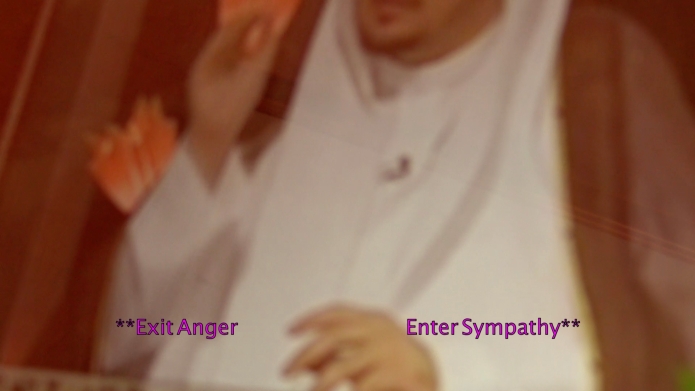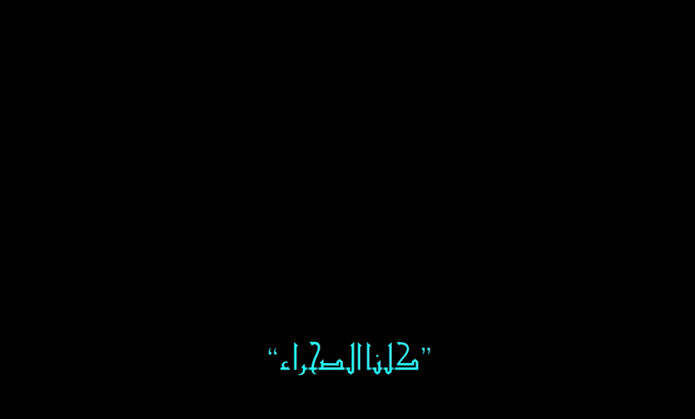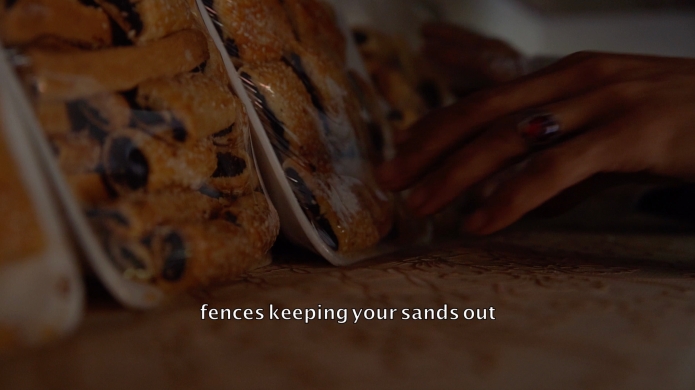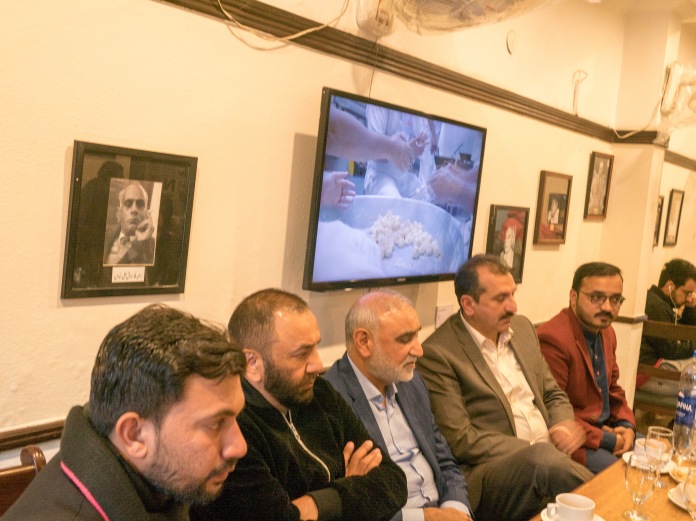
Moza Almatrooshi, photo courtesy of the Muslim Sisterhood
I’m really excited to share with you the work of Moza Almatrooshi. She is a multidisciplinary artist based out of Sharjah in the United Arab Emirates. For me, the goal of Painting in Text has been not only to show artists with interesting outlooks on their practice but to create awareness of art happening outside of our own spaces and hopefully create connections through that. It was an absolute pleasure talking to Moza about her practice. She was very generous and open with her answers, which I really appreciated. The depth of thought she puts into each aspect of her work is astonishing and I hope from reading this you gain as much from the interview as I did.
How important is writing in your practice
For me, they are one and the same. I would say all of my moving image works have required writing. There hasn’t been a video piece where I haven’t written something that really framed things. There is movement to text. In Arabic, alphabetics [a practice of writing which focuses on the representation of spoken sounds by means of letters] looks like this. It is not what you would call text-based work; it focuses on what the Arabic alphabet itself can do. As much as I would like to explore language in that direction, I’m very much still in a mode of explaining my work with text as narrative driving something forward. For me, text is an element in which I can play in exciting ways, where I can use my writing in Arabic in an almost childlike way, to express myself. For example, the narrative of To Whom the Sun May be of Concern is expressed in this fable form which was evident in the video piece. It seems like something that could be read or spoken to a child but it has this kind of dark ending that’s not appropriate. I like that it comes across as very unalarming – something that takes a formal language. Arabic in its classical form is very formal. I feel like this style of story writing is disarming, and that’s why I rely on it to pair up with the other works although it can also stand alone.
There is a prominent use of subtitles in To Whom the Sun May be of Concern. Could you talk a bit about that?
I made To Whom the Sun May be of Concern at a time when I was thinking of the idea of access purely in a linguistic sense. I’m not claiming that English is not a poetic language or anything but I couldn’t exactly match the poetics of my language within English without sounding a bit off. Things get lost in translation. So, I made the conscious decision to keep the English subtitles as basic and to the point as possible. And I use Arabic in an ornate way with different colours assigned to the different characters that come into play. There is no third-person narration just characters that speak.

To whom the Sun May be of Some Concern, (2018), still
The yellow subtitles translate what I’m voicing in the film. I played with different fonts In one scene, the subtitles were symbols. In another, there is a kind of stylised Arabic font. At that point, I was making the work for an exhibition in Sharjah, and I was playing a lot with political slogans specific to the situation here in the United Arab Emirates. I thought it much more important to push forward language that the people living here could pick up on because it was made for them to view. But within all my work, there is a dense layer of vagueness. I try to find subtle ways of working ideas into my practice.

To whom the Sun May be of Some Concern, (2018), still
You speak multiple languages. Does that affect your writing and visual practice?
I wouldn’t say that I’m bilingual as much as I would say I have this kind of duality in my mind because I think in both languages constantly. I feel like I dream in English. I was working with an editor while writing something for a publication, and when she looked at my text she said, “I could tell that you had translated from English [into Arabic] in your mind.” I didn’t know how to respond to that! It happens both ways where sometimes I might think in one language and translate it into the other, and vice versa, to see what works. This is going to sound clichéd but sometimes I feel like [the texts] write themselves. It surprises me more when that happens In Arabic because, although it’s my first language, I speak Emirati. Nobody speaks classical Arabic in a colloquial sense. It just doesn’t exist in that way. It’s used in the Quran and formal settings – on the news or in formal letters.
Your recent work, Glaze features in this year’s Lahore Biennale. How did Glaze come about?
I was doing a residency in Cairo around Autumn 2019, while working on a commission for a five-minute film as part of the BBC New Creatives scheme. I went to a bakery that makes Western pastries. What is fascinating about them is I don’t know how to explain this better they make Western pastries in an Arab twist. For example, the croissants were rolled differently and their éclairs are really huge. The resulting work [Staff of Life] is my experience of not only documenting that but working with a sound designer and other artists who lended me their voices for the narrative. It was so amazing but I had that restriction of five minutes. From that, I wondered how I could do that again but in Sharjah. That way, I could take my time with the process. So with Glaze, I focused on the different kinds of spaces in Sharjah that make desserts.

Staff of Life, (2019), still
What was great about this project was that I was working with a sound designer to create noise as a form of language that went along with movements similar to those in Staff of Life. The focus of Staff of Life is on the hands of the bakers as they make or decorate something. Usually, they’re using big machines to do something very traditional, which was interesting to see. The way they move their hands while preparing or pouring; I thought, why don’t I translate these movements instead of narrating in my usual way? Why don’t I translate these everyday gestures into sound?

Glaze, (2020), still
Glaze has arrived at a version which very much fits the teahouse in Lahore, Pakistan where it’s being shown. The Pak Teahouse is one of the locations of the Biennale, and it’s supposed to be a significant space for people to gather and discuss politics. I felt that the location worked well and that whoever goes to see the work will be able to absorb everything that is said. It is very much a version that I would like to revisit and do something a bit different with down the line. But at the moment, it’s a moving-image work with sound created for the visuals that tell a story. Using the Tea House as a venue allowed for additional elements to the work such as a menu which itself was a translation of the story. The staff of the teahouse helped with what they could access within their work limitations. With a few adjustments, the work can be consumed as a meal or a tea, or a coffee.

Glaze showing in Pak Teahouse Lahore, (2020), photo courtesy of Lahore Biennale Foundation
For me, Glaze was about these visuals that lure the viewer in – the fuzzy feelings people get while watching sweets being made. All of these things that are so beautiful to look at. Even without all the layers I’m injecting into the work, on an elementary level, these things being made are bad for you but it is so easy to be seduced by them. That was basically what I was trying to do.
Food is a common theme in your work. Could you discuss the motivation behind that?
All the food that we eat has heavy symbolism within Arabian culture. Foods like pomegranates, dates, honey, flatbread all have symbolism associated with them – not just in what they represent but also how they are consumed – and this is just as important in pre-Islamic Arabia. Some of my work is about how these rituals in Islamic culture have been appropriated from Pre-Islamic times. That knowledge is important.

Moza performing Evergreen, (2018), photo by Meera Alqasimi
Evergreen was born out of the frustration of having to translate everything I did. This realisation that when I write or communicate something through any of my works that use text, it must be in English – even here in the UAE. Obviously, it’s because it is the dominant language and there has to be a common language but I couldn’t help but think about this in terms of access. Why does art have to be English to be accessible? That coupled with the experience of being asked really frustrating questions in art school like, when I would be working with ceramics: “is this a response to ISIS?” Completely out of nowhere! As if I’m supposed to have these prepared answers about something because of my cultural or religious background.
When picking materials, I choose foods well known for their symbolism. The pomegranate is significant to a lot of cultures, and both Eastern and Western cultures. It could be something for everyone, regardless of what it means to me. From that starting point, the performance then became about an interaction with a guest through a gestural rather than. To eat the pomegranate after I had sliced it in front of them and went through all that labour; how do they respond to that? How much do they take? Some people just ate one little bit, some took a handful, some people shared their plate, and that was the idea behind it. I found that after that, everything I wanted to say could be said with food – whether a cooking method or a [visual] element. That is why I’m now going to culinary school. I feel I can actually use that, integrate it into my practice and also create some sort of financial stability for myself.

Evergreen, detail, (2018), photo by Meera Alqasimi
Evergreen was a performance within a larger performance from a group that the Arab Art Salon formed with friends at the Royal College of Art. Basically, we decided to use a domestic space to do a series of performances for one night and invite everyone from the neighbourhood plus our course mates – everyone we could fit. So, it wasn’t just the typical audience you would encounter in white cube spaces. I think as much as I’d love to say the space was very considered, it wasn’t. We were all pleasantly surprised by the way in which people absorbed the performances in a domestic space. That was what the Arab Art Salon was all about; we were just together at a particular time expressing our concerns to one another. We all more or less came from the Gulf States and there are certain things we can’t discuss in these countries (and in London, to a lesser extent). So we felt that it was so important to have this kind of space. It wasn’t about critiquing each other’s work as much as it was about sharing. We thought that a domestic setting would be the best place to accomplish that. These kinds of initiatives that bring people together in person are so important because I don’t think it can be achieved in the same way online.
Your practice involves so many different processes, it would be interesting to see what a day in the studio looks like for you.
Most of my work is research-driven, so you would see a lot of research. I’m still trying to excavate knowledge that has been lost, particularly around pre-Islamic heritage. Much of that information has been destroyed or was never really recorded well enough to begin with. It’s tough to identify how reliable the sources actually are with the very little information that is out there. The past few months have been like a loop of trying to find reliable information or important myths, and figure out how these can also feed into works.
When I’m not researching, I’m just really reactive to what is going on here in UAE, and that drives a lot of my thinking. In the meantime, I’m graduating from culinary school in autumn and I will hopefully have my new studio set up before summer. I’m going to have a kitchen where I will host artists and create exchanges around how they work with food or other materials. The artistic community is really small in UAE; it would be nice to have a space here that is outside of any institution. When we gather and organise ourselves as artists, and really talk about things that matter, it’s much more organic. It’s not trying to be anything other than what it is. I’d like to cultivate that.
You can find out more about Moza Almatrooshi’s work through her website link below
thank you Meadhbh McNutt for your work editing
You can support Painting in Text through Patreon, link below
https://www.patreon.com/PaintinginText
